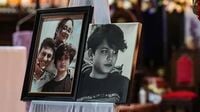The city of Sheffield has been left reeling after a 15-year-old schoolboy, Harvey Willgoose, was fatally stabbed by a classmate in a shocking incident that has reignited a national debate about youth violence and the dangers lurking within British schools. The case, as reported by BBC and Sky News, has not only devastated the families involved but has also raised urgent questions about the responsibility of educational institutions and the legal system’s approach to young offenders.
On February 3, 2025, what began as an ordinary school day at All Saints Catholic High School in Sheffield ended in tragedy. Harvey Willgoose, described by his family as “kind, loving, and deeply cherished,” lost his life during the lunch break when he was stabbed by fellow student Mohammed Umar Khan. Both boys were just 15 years old, their futures ahead of them—until a confrontation escalated into irreversible violence.
According to court evidence cited by BBC, the two teenagers had an earlier altercation that day. They had reportedly “squared up” to one another, a phrase that, in the context of schoolyard disputes, often signals a brewing fight. CCTV footage revealed Khan pushing Harvey in a corridor before the lunch break. The tension did not subside; instead, it escalated. Witnesses later saw Khan brandishing a knife in the school cafeteria, a chilling prelude to the fatal attack that would follow.
In the aftermath, the shockwaves extended far beyond the school’s gates. The case was widely covered in the national press, with Sky News highlighting the profound sense of loss experienced by Harvey’s family and the urgent questions now facing the wider community. Harvey’s sister, Sophie, delivered a heart-wrenching statement in court, saying, “This was not just a crime against Harvey, this was a crime against all who loved him.” She described the killing as “cruel and inhumane,” and revealed the added pain that their grandfather, who had attended the trial in search of justice, had died just a week before the sentencing.
The court proceedings revealed disturbing details about Khan’s behavior in the months leading up to the attack. As reported by BBC, Khan had a documented history of bringing weapons to school. His mother had previously discovered an axe in his school bag, and classmates testified that he often acted as if he was armed. This pattern of behavior, combined with the events of February 3, painted a picture of a troubled teenager—one whose issues went unaddressed until it was too late.
During the trial, Khan’s defense team argued that he was not a cold-blooded killer but a boy who acted in the heat of the moment, driven by fear and emotional distress. According to Sky News, Khan reportedly told those present after the stabbing, “I’m not right in the head, my mum doesn’t look after me right.” His lawyers cited bullying and humiliation by other students, though notably not by Harvey himself, as contributing factors to his mental state that day. Nevertheless, the prosecution maintained that Khan’s actions were deliberate and retaliatory, pointing to the number of stab wounds inflicted and the opportunities he had to walk away from the confrontation.
The sentencing, delivered on or about October 22, 2025, was a moment of reckoning. Judge Mrs Justice Ellenbogen imposed a life sentence with a minimum term of 16 years, a decision designed to reflect both the gravity of the crime and the youth of the perpetrator. In a move that has sparked significant legal and social debate, the judge also decided to lift Khan’s anonymity—an unusual step for a minor in the UK justice system.
Explaining her decision, Mrs Justice Ellenbogen stated that the “circumstances of this case are of substantial public interest.” She argued that the issue of knife crime among young people is a matter of major public concern, and that the public had a right to know the identity of the perpetrator in such a high-profile and troubling case.
The response to the lifting of anonymity has been mixed. Some legal experts and child welfare advocates worry that naming young offenders could hinder their rehabilitation and expose them to further harm. Others, however, believe that transparency is essential in cases where the safety of the wider community is at stake. As BBC noted, the decision has reignited a longstanding debate in the UK about whether youth offenders convicted of serious crimes should be shielded from public scrutiny.
Beyond the legal arguments, the tragedy has forced a reckoning within the education sector. Schools across the UK are grappling with the question: how can such violence be prevented? The fact that Khan was able to bring not just a knife, but previously an axe, onto school premises has raised serious concerns about the effectiveness of current safety protocols. Parents, teachers, and policymakers alike are now calling for urgent action to address what many see as a growing epidemic of knife crime among young people.
According to Sky News, the case has also highlighted the complex interplay of mental health, family circumstances, and peer dynamics that can contribute to youth violence. Khan’s defense team acknowledged the “tragic, senseless loss of a young innocent life” and conceded that while their client had suffered humiliation, “it is nothing compared to what Harvey’s family will be experiencing.”
The sentencing marks the end of a painful chapter for the Willgoose family, but the wider conversation about youth violence in Britain is far from over. The case has prompted calls for increased mental health support in schools, better communication between parents and educators, and stricter measures to prevent weapons from entering school grounds. As communities across the country reflect on the lessons of Sheffield, there is a growing sense that more must be done to protect young people from the dangers that can arise even in the most familiar of settings.
In the end, the story of Harvey Willgoose and Mohammed Umar Khan is a stark reminder of the fragility of youth and the devastating consequences that can flow from a single moment of violence. As the city mourns, the hope is that this tragedy will serve as a catalyst for real change—so that no family has to endure such heartbreak again.





